History of the Hampton Fire Department
A tradition of service, courage and pride
Courtesy of Atlantic News & Advertiser
January 10, 1984
Back to previous section — Forward to next section — Return to Table of Contents
– SECTION 7 –
Merrill Lumber Company Fire Does $100,000 Damage
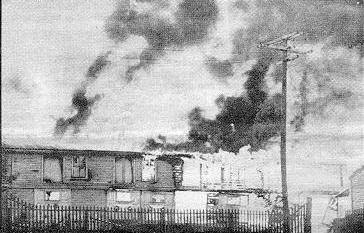
7 Dearborn Avenue
August 4, 1966
HAMPTON — On August 4th, 1966, fire broke out in the office of the Merrill Lumber Co., Dearborn Avenue, Hampton, and before it could be finally put out, damage estimated by the Hampton Fire Department at $100,00 had been done. Although neighbors reported, after the fire, that they had smelled smoke Wednesday night, flames were not visible Thursday when Leslie B. Merrill, owner, came to work. According to Merrill, the fire broke out when a bang or small explosion followed the opening of the safe. He said that almost immediately, the office was in flames.
The first call for the Hampton Fire Department logged in at 7:10 a.m. on Box 179 by a neighbor on Dearborn Ave.
Fire Chief Perley George said, “We think it started around the heater, but it was cold in there that night and the heater was on.” Commenting on the fact that no one had reported smoke during the night to his department, he said, “You’d think they would have called us.”
By 7:30 a.m., the fire seemed to be under control, with damage confined to the West end of the main building, but shortly after, flames began again and at 7:33 a.m., the Hampton Falls Department was called in, followed at 7:46 a.m. by the Exeter, North Hampton and Seabrook Departments and Mutual Aid in Portsmouth.
Sometime while the fire was being fought in the west end of the building, the owner’s son (Steve Merrill, who later became governor of New Hampshire) opened the east door and drove to safety the two vehicles that were parked in the building, according to the fire department sources. George said, “I guess we had it (the fire) out and then they opened the doors and it started up again.”
When it became apparent that more water was needed, fighting units moved out and tapped hydrants in Hampton Center on Lafayette Road and on High Street a block away at Academy Avenue.
Robert F. Wieners, Manager of the Hampton Water Works Company reported that pumping records indicate a total of 320,000 gallons or 1,300 tons of water was used to extinguish the Merrill Lumber Yard fire.
Wieners noted that the Mill Road Tank remained full during the entire fire demand period, while the Glade Path Elevated Tank gained approximately 20,000 gallons.
Water Company wells were producing 3,200 gallons per minute and Wieners estimated that water used at the fire scene, reached a maximum demand of 2,500 gallons per minute.
Over 2700 feet of 21/2 inch hose was used by the Hampton Department and an additional 650 feet of 11/2 inch hose was called into play. Other departments also used many hundreds of feet of hose to lay lines along High Street and Dearborn Avenue.
Fifteen call firemen in Hampton were called out in addition to all regular duty men and several of those at the fire received burns on their faces and hands due to the intensity of the heat.
Hampton Beach Conflagration — 1915
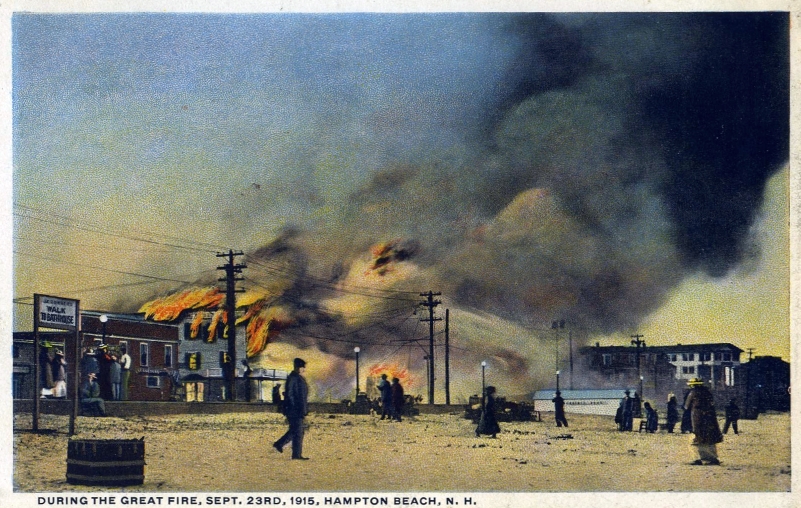
After the summer festivities were over and the tourists had left and cottage owners had “closed” their homes until next season, the resort beach and boardwalk soon became the sole domain of a few year-round residents. On Thursday, September 23, 1915, a fire broke out on B Street a short distance from Ocean Ave. Before it had been extinguished over forty cottages, six hotels, two theatres and the Episcopal Church had been destroyed.
At first the fire, which was reported shortly after 4:00 p.m., was thought to have started in the back of “Graves” Drugstore in a box of excelsior left over from carnival week, but later evidence suggest that it started at the “Seymore” Cottage owned by James Garland, caused by children playing with matches. No one really knows. The local fire department headed by Chief L. C. Ring responded. Chief Ring immediately requested aid from Portsmouth, Newburyport, and other area towns.
From the point of starting on B Street, the fire worked mainly in a northerly direction. Buildings on the South side of B Street were badly scorched. As the fire swept along the ocean front the “Fairview, Ashworth, Janvrin, Lawrence House, DeLancy, and Grand View” were reduced to ashes. The Ring Block was destroyed which housed Ferncroft Garden and Dance Hall. Also consumed was the Post Office, Olympia, and Strand Theatres. The fire then worked its way down Nudd Avenue where the firemen used dynamite to blow up cottages in the path of the fire. The Episcopal Church, St. Peter’s by the Sea, caught fire and began to burn. The steeple finally collapsed and the bell gave one last doleful clang as it tumbled into the burned ruins. But the church marked the northernmost extent of the fire ravages. From B Street to Highland Ave., more than half of the entire business section of Hampton Beach and all of the cottages, hotels and guest-houses in the rear had been completely destroyed. By 7:45 the last of the flames had been put out. No one was killed and only one man, a house guest on B Street was injured.
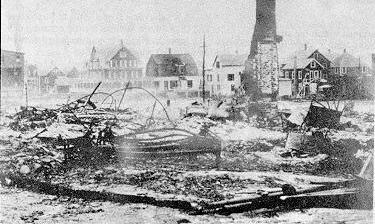
A great conflagration attracts crowds. Curious people flocked to Hampton Beach by the thousands. Not one in a hundred would give assistance. They stood idle and watched hose burn up — too indifferent to pull it out of harm’s way. And most of the onlookers merely looked at men who were carrying the best pieces of furniture out of houses destined to be burned; they never offered to help.
There had been other serious fires at Hampton Beach. The first one occured in the early summer of 1885. In the fall of 1903, property of Dudley & White Studio and Restaurant and the Little & Singleton cottage was burned. And there was the big blaze of November 13, 1911 which destroyed the Pentucket House and three cottages. The Ashworth had just been built replacing the first hotel by that name which had been itself destroyed by fire two years before. Hampton Beach was becoming conscious of the need for more efficient fire protection and so in 1915, there was a volunteer fire company with minimum equipment which included a combination hose and chemical and hose reel, which was quartered in the Ross Barn, when this great conflagration broke out. Luckily, hydrants had been installed along the boulevard in the center of the beach.
Hampton Beach Second Great Conflagration — 1921
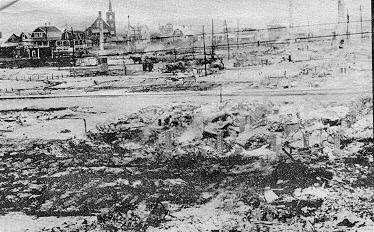
St. Patrick’s Catholic Church in left background.
The rebuilt section between B Street and Ashworth stood exactly five seasons. Then on June 26, 1921, it happened again. The second big fire started in the same section – B Street, and razed everything as far north as the Ashworth. Here, a combination of happy circumstances ended the conflagration. First, the wind lessened and changed direction; second, asphalt shingles which covered a cottage occupied by Billy Lamb proved an efficient fire-stop, and third, a group of Newburyport firemen, shielded by doors, stood in the intersection of Marsh Avenue and the boulevard and continued to play two lines of hose on the blazing building at the corner, where the Delta Block was, in spite of heat so intense that the sides of the door shields toward the fire blazed occasionally and had to be continually wet down by firemen stationed with a line of hose on the boulevard, just south of the intersection.
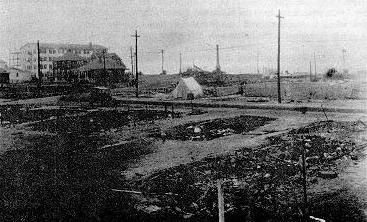
The fire covered an area of seven or eight acres and the losses aggregated fully as much as in 1915, for all the buiness places were stocked for the opening of the 1921 season and the buildings were more substantial than those destroyed six years previously. Before the 1921 ruins were done smoking, the Chamber of Commerce had caused a great sign to be erected in front of the ruins near the head of B Street. On it, in letters two feet high, had been painted the old slogan of the Salvation Army, “Down But Not Out!” And under that in even bigger letters: “Watch Us Grow!”
Fire At Hampton Beach — 1923
Hampton Beach was again visited with a disastrous fire Sunday morning, June 24, just two years after the big fire, which swept the Boulevard (in 1921). The fire started in the garage of Mrs. Frank Bristol, in which 22 automobiles wer stored and all were burned. It is thought by authorities that the fire started from a short circuit in one of the cars. Although a night watchman was present, so rapidly did the fire spread, not a car could be saved. Flames rapidly spread to two cottages, which were completely destroyed and a small hotel was completely gutted, the guests having barely time to dress and make their escape. All kinds of high priced machines were destroyed, one owned by Fred McCabe, of Haverhill, a new Packard, costing $4,000 a week before. It is reported only fifteen were insured against fire.
An abundance of water, coupled with the efficient handling of the powerful pump, prevented a more serious fire, but the action of Chief Brown in appealing for aid from Amesbury, Newburyport, Exeter, Portsmouth and other places was a wise precaution, and it is generally commended, and the prompt appearance of apparatus from these places at the fire was much appreciated. The loss was very large and difficult to estimate.
A Third Conflagration Hits Hampton Beach
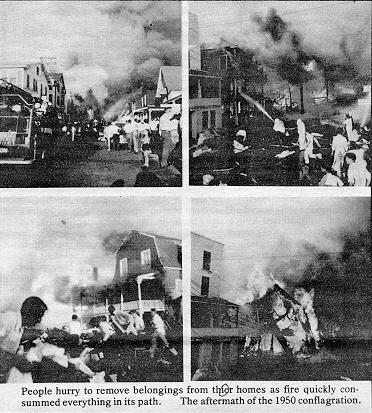
Only a few people realize how truly terrible a great fire can be, because only a comparatively few people have been involved in one. In the Hampton Beach conflagrations twenty or more buildings would be burned at once. The heat is so intense that cottages and hotels in the path of the fire would be consumed spontaneously. They would seem to explode with a muffled roar and disappear almost instantly before your very eyes. The roar of a great conflagration can be heard half a mile away and burning sparks and sizable embers are sometimes carried more than a mile. And once it has secured a good start, the speed at which a conflagration moves is almost incomprehensible.
It was not until July 14, 1950 that there has been any type of conflagration which could even be compared with the great fires of 1915 and 1921. On that day we had the “C Street Corner Fire” which destroyed several business blocks and cottages. This blaze would have been more nearly comparable with ’15 and ’21 had it not been for an efficient fire department and a new salt water hydrant system which was pressed into active service, even before completion.
The fire broke out in a storage shed in the rear of Dudley’s Gift Shop and Hotel at 6:15 p.m. Shortly after arrival of the local fire department mutual aid was sent in from Portsmouth, Salisbury, Amesbury, Newburyport, Hampton Falls, Newington, Exeter, and Seabrook. The blaze consumed close to a half million dollars in damage. For the third time, a section, nearly the same area as the previous conflagration, of Hampton Beach had to be rebuilt.
